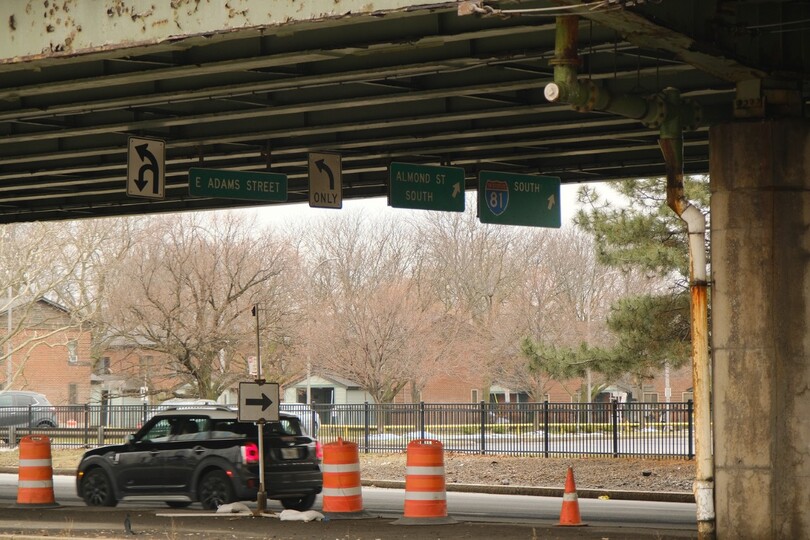Syracuse forum announces new air quality monitoring projects in anticipation of I-81 demolition

Maxine Brackbill | Asst. Photo Editor
With the destruction of the Intersate 81 viaduct still pending, two projects look to distribute approximately 17 air quality sensors near I-81 and around the city of Syracuse area, with support for the project extending to the Syracuse City School District, SUNY ESF, the city of Syracuse, and other partners. SUNY ESF Assistant Professor Jaime Mirowsky announced details about the new air quality sensors Monday afternoon at a forum hosted by the Syracuse Center of Excellence in Environmental and Energy Systems.
Get the latest Syracuse news delivered right to your inbox.
Subscribe to our newsletter here.
In anticipation of the demolition of the Interstate 81 Viaduct, SUNY ESF Associate Professor Jaime Mirowsky announced details for two new air quality monitoring projects, both aimed at installing a permanent network of monitors across the city of Syracuse.
The two projects announced at the event — a forum hosted by the Syracuse Center of Excellence in Environmental and Energy Systems — will distribute approximately 17 air quality sensors near I-81 and around the Syracuse area to track and publicly report air quality data.
The first project will focus on installing at least three high-quality monitors throughout the I-81 corridor. The second project will track air quality regionally by distributing approximately 14 lower-quality sensors around the Syracuse area in schools, businesses and public libraries.
Mirowsky said advisory board members who support the project — including those from the Syracuse City School District, SUNY ESF, the city of Syracuse, Upstate Medical Hospital and the Onondaga Environmental Institute — will collectively determine specific locations for the sensors.
In addition to implementing the new sensors, Mirowsky noted that the collaborative effort will work with SCSD to create two different academic modules in order to educate students on air quality control and measurement, including one program for elementary school students and one geared toward high schoolers.
“It is really important that when we do this, we set up a system so that anybody who wants to access the air quality data at that time (is able to), so they can make informed decisions potentially that day,” Mirowsky said.

Dominic Chiappone | Asst. News Editor
Setting up at least one high-quality sensor to collect preliminary air quality data ahead of the I-81 viaduct’s planned demolition remains a priority, Mirowsky said. She hopes to have the sensor for preliminary data installed by this summer.
Demolition of the viaduct is currently on pause following a February ruling from State Supreme Court Judge Gerard Neri, who cited insufficient evidence of the demolition’s environmental consequences, including the lack of an air quality analysis. The ruling, which allowed the state to proceed with the I-481 section of construction, came after a November ruling which halted the plans altogether in favor of the plaintiff group “Renew 81 for All.”
In March, the city of Syracuse and New York state filed an appeal against Neri’s ruling, but as of Monday there has been no change in decision.
Jensen Zhang — the executive director of the Syracuse Center of Excellence and a professor in the College of Engineering and Computer Sciences at Syracuse University — emphasized the importance of bringing different members of the community together in the pursuit of providing the most holistic perspective on air quality tracking.
Zhang said he’s hopeful that publishing collective air quality data to the Syracuse community can pave the way for future solutions to keep city residents healthy.
“It’s important to have all the communities here emphasized so we can actually have a very accurate assessment of who is exposed to these pollutants and to what extent their health is impacted,” Zhang said. “And then that’s the first step: make an assessment. Our ultimate goal is to find ways to mitigate the problem.”
Mirowsky said the group is working to provide easy access to the data via JustAir, a company which functions to distribute air quality data to communities, as well as planning to prioritize community engagement and outreach efforts.
Zhang also noted the need to monitor air pollution if the I-81 viaduct is torn down, especially if the area’s high traffic remains the same.
“Renew 81 for All” argued in its September lawsuit that the city of Syracuse and New York state did not conduct thorough reviews of the impacts of the highway’s destruction on residents in the area. Specifically, the plaintiffs argued that changes in traffic patterns could cause a decrease in air quality.
Mirowsky emphasized the urgency of expediting the implementation of sensors near I-81 to gather preliminary data, restating the priority of working directly with the community.
“The idea is to foster a lot of relationships between researchers, community groups, local nonprofits, and get us all working together for the purpose of air quality monitoring in these neighborhoods,” Mirowsky said.





